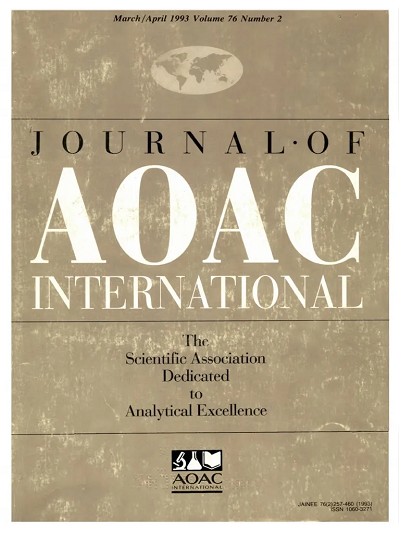Determination of Toxic Elements in Botanical Dietary Supplement Ingredient Reference Materials
IF 1.7
4区 农林科学
Q3 CHEMISTRY, ANALYTICAL
引用次数: 0
Abstract
Background The National Institute of Standards and Technology (NIST) has produced over 40 botanical dietary supplement Standard Reference Materials® (SRMs) and reference materials (RMs) with values assigned for chemical markers and/or active compounds. Although environmental accumulation or inadvertent introduction of toxic elements (arsenic, cadmium, lead, and mercury) is a potential source of exposure in botanical dietary supplement products, the majority of the dietary supplement SRMs/RMs do not have values assigned for the four major toxic elements. Objective To determine As, Cd, Pb, and Hg content in the current inventory of NIST botanical dietary supplement SRMs/RMs. Methods Fifteen SRMs/RMs suites of plant part, extract, and finished products [i.e., solid oral dosage form (SODF)] were analyzed for As, Cd, Pb, and Hg using nitric acid microwave-assisted digestion followed by quantification using inductively coupled plasma—mass spectrometry. Results Results for control samples were in good agreement with certified values indicating that the analyses of 38 individual botanical SRMs/RMs were in control. Characterization of linked plant/extract SRMs/RMs derived from the same source materials demonstrated that while extraction processes can often yield extracts with lower toxic element content for Hg or As, it is also possible for mass fraction levels to remain unchanged or even increase following extraction. Conclusion The results fill significant knowledge gaps in toxic element content ranges for SRMs/RMs where no NIST assigned values existed, in particular for Hg content and for extract and SODF matrices. With comprehensive toxic element content now available, researchers can better select appropriate dietary supplement SRMs/RMs for use as controls in the analysis of dietary supplement ingredients and products. Highlights Results for As, Cd, Pb, and Hg are reported for 38 dietary supplement SRMs/RMs including 6 suites of plant, extract, and SODF and 9 pairs of plant and extract from the same batch of plant material.植物膳食补充剂成分参考材料中有毒元素的测定
背景 美国国家标准与技术研究院(NIST)已生产出 40 多种植物膳食补充剂标准物质® (SRM) 和参考物质 (RM),并对化学标记和/或活性化合物进行了赋值。虽然有毒元素(砷、镉、铅和汞)的环境累积或无意引入是植物膳食补充剂产品的潜在暴露源,但大多数膳食补充剂标准物质/标准参考物质都没有为这四种主要有毒元素赋值。目标 确定 NIST 植物膳食补充剂 SRM/RM 现有库存中的砷、镉、铅和汞含量。方法 利用硝酸微波辅助消解法分析植物部分、提取物和成品[即固体口服剂型 (SODF)]的 15 个 SRMs/RMs 套件中的砷、镉、铅和汞含量,然后利用电感耦合等离子体质谱法进行定量。结果 对照样品的结果与认证值十分吻合,表明对 38 个植物 SRM/RM 的分析处于受控状态。对来自同一来源材料的相关植物/提取物 SRM/RM 的表征表明,虽然萃取过程通常会使提取物中汞或砷的有毒元素含量降低,但也有可能在萃取后质量分数水平保持不变,甚至有所增加。结论 这些结果填补了 SRMs/RMs 毒性元素含量范围方面的重大知识空白,因为 NIST 并没有为 SRMs/RMs 赋值,尤其是汞含量以及萃取物和 SODF 基质。现在有了全面的有毒元素含量,研究人员就能更好地选择适当的膳食补充剂 SRM/RM,在膳食补充剂成分和产品分析中用作对照。亮点 报告了 38 种膳食补充剂 SRM/RM(包括 6 套植物、提取物和 SODF 以及 9 对来自同一批植物材料的植物和提取物)的砷、镉、铅和汞含量结果。
本文章由计算机程序翻译,如有差异,请以英文原文为准。
求助全文
约1分钟内获得全文
求助全文
来源期刊

Journal of AOAC International
医学-分析化学
CiteScore
3.10
自引率
12.50%
发文量
144
审稿时长
2.7 months
期刊介绍:
The Journal of AOAC INTERNATIONAL publishes the latest in basic and applied research in analytical sciences related to foods, drugs, agriculture, the environment, and more. The Journal is the method researchers'' forum for exchanging information and keeping informed of new technology and techniques pertinent to regulatory agencies and regulated industries.
 求助内容:
求助内容: 应助结果提醒方式:
应助结果提醒方式:


